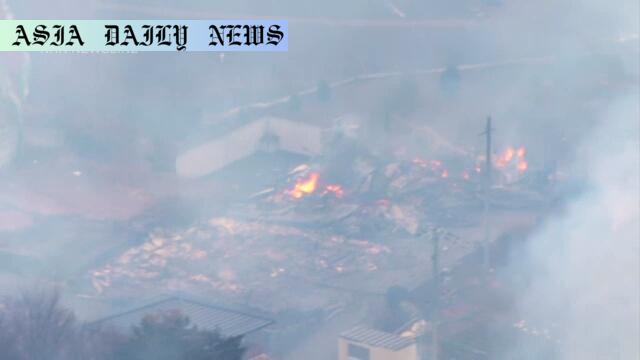Wildfire: Over 2,100 hectares scorched, evacuation orders issued to 1,202 residents in northeastern Japan’s Ofunato City.
Wildfire burns 2,100 hectares of land in northeastern Japan.
1,202 people evacuated from Ofunato City’s affected areas.
Firefighting operations continue amid dry conditions.

Unyielding Wildfire Rages Across Northeastern Japan
In a grim turn of events, northeastern Japan continues to reel under the catastrophic impacts of a wildfire that erupted five days ago in Iwate Prefecture. The devastating blaze, concentrated in Ofunato City, has already consumed approximately 2,100 hectares of land as of Monday morning. The Akasakicho Sotoguchi district, one of the hardest-hit areas, bears the aftermath of destruction, with buildings reduced to skeletal frameworks and flames still licking parts of the structures. Additionally, an NHK helicopter survey revealed thick white smoke emanating from multiple mountain forests, signifying the vast stretch of uncontrolled inferno.
While firefighters are working tirelessly day and night to suppress the flames, the surrounding Sanrikucho Ryori district is witnessing the wildfire inch dangerously close to residential neighborhoods. Fear and uncertainty loom over residents, as an evacuation order has been imposed across wide areas of Ofunato City.
Evacuations Rendered Essential Amid Pervasive Damage
By 11 a.m. on Monday, local officials reported that 1,202 residents had evacuated to 12 designated shelters, prioritizing human safety amid the uncontrollable blaze. Though the firefighting operations have been relentless, they are hampered by the dry weather conditions which exacerbate the intensity of the flames. Yet, a glimmer of hope emerges from weather forecasts predicting a shift in conditions. Snowfall is expected to begin by early Wednesday, transitioning into rain by noon, and could potentially aid firefighting efforts. Officials further anticipate the precipitation to peak by Wednesday night and continue through Thursday morning, offering a crucial reprieve in this dire situation.
Environmental and Human Impact of the Wildfire
The wildfire’s unabated march has inflicted significant environmental and human distress, impacting local ecosystems and displacing over a thousand residents. The Akasakicho Sotoguchi and Sanrikucho Ryori districts are among the most severely affected areas, enduring extensive property damage and ecological loss. Entire forests, an essential component of Iwate Prefecture’s natural landscape, have been left charred, further propelling concerns about long-term environmental consequences. Furthermore, the looming threat of fire encroaching on urban areas serves as a stark reminder of the unpredictability and destruction such natural disasters can trigger.
Hope for Relief as Weather Changes Loom
As efforts continue to combat the flames, the forecast of snowfall and rain is a beacon of hope for Ofunato City. Emergency response teams, alongside local authorities, are urging for vigilance and cooperation from citizens while firefighters capitalize on the anticipated change in weather to their advantage. However, rain alone cannot erase the aftermath of this calamity—rebuilding lives and properties will demand a concerted, long-term effort involving government initiatives, local leadership, and community resilience.
With a catastrophe of this magnitude, it becomes essential to focus not just on immediate recovery measures but also on revamping disaster preparedness to mitigate risks in the face of future calamities. The case of Ofunato underscores the urgency of proactive measures to safeguard people, property, and the environment from such destructive events in the future.



Commentary
Wildfire Challenges and the Need for Resilience
The ongoing wildfire in northeastern Japan is a grim testament to the devastating influence of natural disasters on human lives and the environment. The catastrophic loss of 2,100 hectares due to relentless flames underscores the compelling need for enhanced disaster preparedness, especially in regions prone to such calamities. The story emerging from Ofunato City is one of undeniable struggle, resilience, and the urgent plea for assistance in the face of overwhelming destruction.
The Role of Weather in Wildfire Management
Among the notable aspects of this wildfire is the critical role weather conditions play in combating such disasters. While firefighters continue their unwavering efforts to quell the blaze, adverse weather, especially dry air, acts as a formidable adversary. The forecasted arrival of snow turning to rain comes as a welcome change, offering much-needed support to the ongoing firefighting operations. Nature’s assistance in the form of precipitation provides a stark reminder of how closely lives and landscapes are tied to environmental dynamics.
Building a Roadmap for Future Safety
The aftermath of this wildfire serves as an opportunity to reflect on preparedness, community resilience, and environmental sustainability. While emergencies necessitate immediate action, long-term policies and infrastructure enhancements are fundamental in mitigating risks. Efforts such as creating firebreaks, improving communication channels, and equipping firefighting departments with advanced tools should become priorities. Moreover, educating communities about appropriate responses during wildfires can empower individuals to act swiftly and responsibly in critical scenarios.
Ultimately, the wildfire in northeastern Japan is more than just a current disaster; it is a call to action for a safer, more resilient tomorrow. The courage and cooperation exhibited by the people of Ofunato City offer hope amidst hardship and remind us of the power of collective endeavor in overcoming adversity.